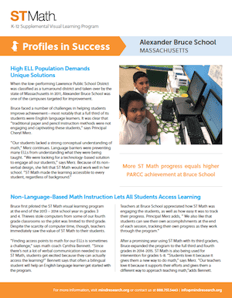School Facts
School Grade Levels: 3-8
School Enrollment: 528
District Type: Large urban
Number of Schools in District: 33
School Enrollment: 528
District Type: Large urban
Number of Schools in District: 33
Demographic Breakdown
Hispanic: 91.9%
Caucasian: 4.9%
Asian: 1.9%
African Amerian: 1.3%
FRL: 95%
EL: 33.3%
Caucasian: 4.9%
Asian: 1.9%
African Amerian: 1.3%
FRL: 95%
EL: 33.3%
ST Math Implementation
Grades using ST Math: 3-8
Type of ST Math instruction: Computer lab, in-class rotation
Type of ST Math instruction: Computer lab, in-class rotation
High English Learners (EL) population demands unique solutions
When the low-performing Lawrence Public School District was classified as a turnaround district and taken over by the state of Massachusetts in 2011, Alexander Bruce School was one of the campuses targeted for improvement.
Bruce faced a number of challenges in helping students improve achievement—most notably that a full third of its students were English learners. It was clear that “traditional paper and pencil instruction methods were not engaging and captivating these students,” says Principal Cheryl Merz.
“Our students lacked a strong conceptual understanding of math,” Merz continues. Language barriers were preventing many ELs from understanding what they were being taught. “We were looking for a technology-based solution to engage all our students,” says Merz. Because of its non-verbal design, she felt that ST Math would work well in her school. “ST Math made the learning accessible to every student, regardless of background.”
Keep Reading...
Visual instruction gives access to all students
Bruce first piloted the ST Math visual learning program at the end of the 2013 – 2014 school year in grades 3 and 4. Thieves stole computers from some of their fourth grade classrooms so the pilot was limited to third grade. Despite the scarcity of computer time, though, teachers immediately saw the value of ST Math to their students.
“Finding access points to math for our ELs is sometimes a challenge,” says math coach Cynthia Bennett. “Since there’s not a lot of verbal communication needed to use ST Math, students get excited because they can actually access the learning!” Bennett says that often a bilingual student will help an English language learner get started with the program.
“Since there’s not a lot of verbal communication needed to use ST Math, students get excited because they can actually access the learning!"
Teachers at Bruce School appreciated how ST Math was engaging the students, as well as how easy it was to track their progress. Principal Merz adds, “ We also like that students can see their own accomplishments at the end of each session, tracking their own progress as they work through the program.”
After a promising year using ST Math with its third graders, Bruce expanded the program to the full third and fourth grades in 2014-2015. ST Math is also being used for intervention for grades 5-8. “Students love it because it gives them a new way to do math,” says Merz. “Our teachers love it because it supports their efforts and gives them a different way to approach teaching math,” adds Bennett.
Keep Reading...Percent of Students Reaching Proficient and Advanced on PARCC

Growth in Percent of Students Grades 3-8 Proficient or Advanced (2015-2016)

From an analysis of grades 3-8 2015-16 PARCC results provided by Lawrence Public Schools. High ST Math achievers progressed through at least 50% of the ST Math curriculum by April 2016
Better engagement results in higher achievement
After just a few years using the ST Math program, “teachers are very bought in,” says Bennett. And they’re seeing the results in student achievement. In 2015-16, 69% of high ST Math achievers (progressing through at least 50% of the program by April) reached the highest levels of math proficiency on the PARCC, as compared to just 35% of students who either did not progress in ST Math or didn’t use the program. In fact, schools across the district have seen this difference in PARCC achievement.
Congrats to the bruce st math champions!!!! pic.twitter.com/eKRYXHBwdn
— ABBruceschool (@ABBruceschool) May 4, 2015
“We’ve seen a real increase in student interest in math,” says Bennett. “They’re really interested in problem solving and showing perseverance in solving the puzzles.” Students are excited to track their progress and want to keep pushing themselves to higher and higher levels. Among her success stories, Bennett points to one student who had trouble focusing in class—largely because he didn’t understand the basic concepts being discussed. “He could be a real challenge in the classroom,” notes Bennett, but ST Math was able to reach him. And he’s not just learning math at school. Bennett says that now he has the highest at-home ST Math usage in his class: “He will be the first to tell you he’s really great at math.”
“We have seen a higher level of confidence in math since starting with ST Math,” says Principal Merz. “We see less of the ‘I don’t like math’ or ‘I’m scared of math’ mindset.”
Parents are on board with the program, as well. As Bennett says, “The parents of our ELs are excited about the technology piece. They’re excited for their children to be learning math on the computer—everyone has an understanding that technology is the future.”

